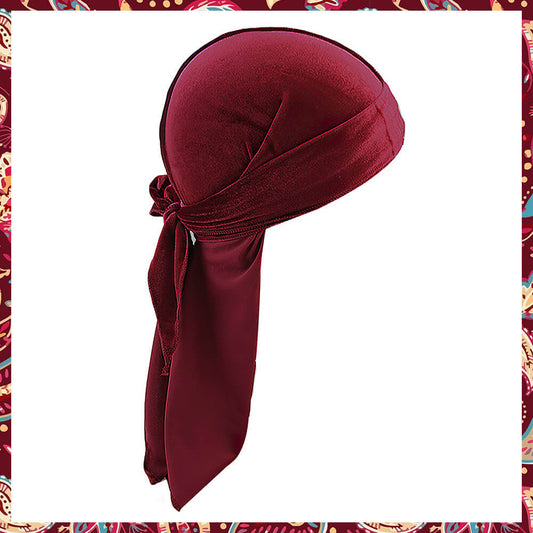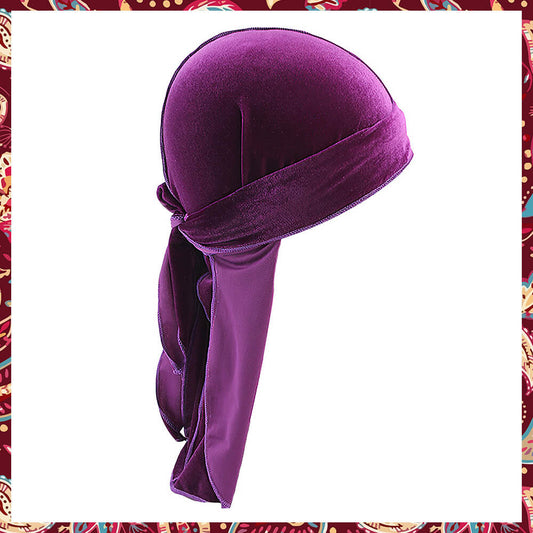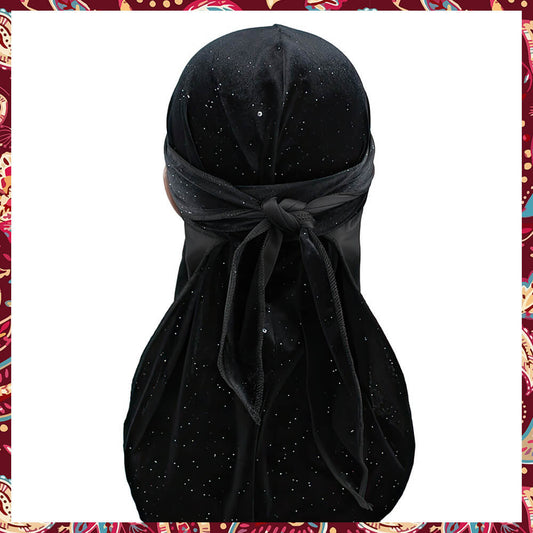Velvet Durags
Impose your look with our collection of velvet durags.
Explore the luxurious realm of our Velvet Durag Collection, which goes beyond a simple accessory. It's a statement of class, culture, and charisma tailored to suit every style palette and effortlessly enhance every outfit you adorn.
Crystals Turquoise Velvet Durag
Crystals Hot Pink Velvet Durag
What is velvet?
Velvet is a fabric that is both soft and luxurious. It has a dense pile of fibers that are cut uniformly while having a smooth surface. The stunning drape of velvet, along with its distinctively soft and lustrous look, is attributed to the specific traits of its short pile fibers.
Velvet is woven, cut, crushed, and primarily made from polyester, rayon, and silk, as well as blends of the three to create a more luxurious fabric. Velvet can also be dense, plush, or knitted, and it can be made from a blend of cotton, which makes it more stretchable.
Velvet is used in various areas, including textiles. It is used in clothing production, allowing for the creation of velvet dresses, scarves, skirts, coats, pajamas, jogging suits, hats, or handbags to enhance femininity.
It allows for dressing in refined tunics and outfits and possessing elegant fashion accessories in one's wardrobe or dressing room.
Velvet has become a favored choice for evening wear and special occasion dresses, originally owing to its silk composition. However, its versatility has expanded to include alternative materials such as cotton, linen, wool, and synthetic fibers, rendering velvet more accessible and well-suited for everyday apparel as well.
Velvet is also used in interior decoration, serving as upholstery fabric, velvet curtains, pillows, comforters, throws, armchairs, cushion covers, and more.
What are the origins of velvet?
The earliest velvets were made of silk and were incredibly expensive, accessible only to royalty and the nobility.
The material was first introduced in Baghdad around 750 AD but eventually spread to the Mediterranean, and the fabric was distributed throughout Europe.
The new technology of looms reduced production costs during the Renaissance. Florence, Italy, became the dominant production center for velvet during this period.
How is velvet made?
Velvet is made on a special loom called a "double cloth" loom, which simultaneously produces two pieces of velvet, like a lining. The velvet appearance is characterized by its consistent pile height, which is usually less than half a centimeter.
Velvet can be crafted in various ways, resulting in different cuts and types such as cotton velvet, corduroy velvet, plush velvet, velour, and more.
Today, velvet is generally made from synthetic and natural fibers, but it was originally made from silk. Pure silk velvet is rare nowadays because it is extremely expensive.
Most velvets marketed as silk velvet combine both silk and rayon. Synthetic velvet can be produced using various materials like polyester, nylon, viscose, or rayon, allowing for a range of options in its manufacturing process.
Velvet Durags
Velvet durags have gained popularity with the resurgence of durags.
While classic durags were typically made from a satin blend, durags incorporating velvet materials on the outside and satin lining on the inside have emerged.
Velvet gives these durags a unique luxurious look while keeping the head warmer during colder periods of the year, such as autumn-winter or even mid-season.
Velvet has the advantage of being a material full of finesse and texture. It is a prestigious and well-regarded fabric synonymous with good quality, much like cashmere, for example.
A velvet durag makes it easier to manage your hair compared to a bandana, turban, headband, or scarf, for instance.
In our collection of velvet durags, you can find a wide range of products, including durags in:
- Blue velvet (navy blue, sky blue, dark blue, midnight blue, turquoise...)
- Red velvet
- Black velvet
- Gray velvet
- Pink velvet (pale pink, fuchsia, dusty rose...)
- Green Velvet (khaki, fluorescent green...)
- And many other colors, including beige, brown, purple, gold, silver, and even multicolor!
How to create waves with a velvet durag?
Originally durags are not specifically designed for creating waves. They are primarily used to protect hair during sleep and maintain a certain style during hair growth.
That being said, velvet durags are perfect for waves. While the exterior is made of velvet, the interior of the durag is lined with satin. Velvet offers better compression than traditional durags and can create beautiful waves.
Traditionally, durags were made from satin. Satin is a breathable weave that typically has a matte back and a shiny surface. Although satin is an excellent material, it can be easily damaged if not properly cared for.
Velvet durags are more durable than satin durags. They often have a better appearance due to their velvet exterior. Satin is still used as the lining in velvet durags, making them perfect for hair care.
How to wash velvet durags?
You should always hand wash your durags. Hand washing allows you to thoroughly clean your velvet durag. Here's how to properly wash a velvet durag:
- Find a mild detergent.
- Place the durag under warm water.
- Add a little detergent to the durag.
- Gently rub the durag to allow the foam to accumulate.
- When water runs through the durag, you should see darker water on the other side.
- Continue washing and rubbing until the water on the other side becomes clear.
- Once the water is clear and all the detergent is gone, hang the durag to dry.
If you ever wash your durag in a washing machine (although we do not recommend it), use a very gentle wash cycle. Additionally, we advise you to always air dry the durag.
Discover also our designer durags collection, featuring exquisite craftsmanship and luxurious fabrics. From silk to velour, each durag is meticulously designed to provide both style and comfort. Elevate your headwear game with our designer durags. Explore our collection now.

























